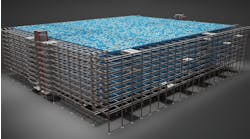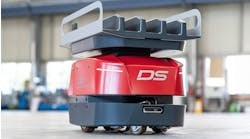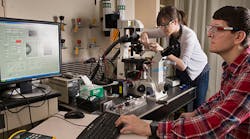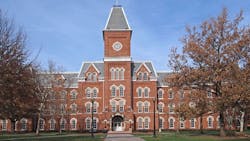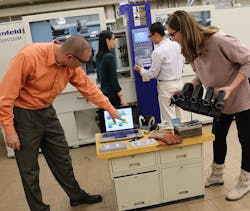While they "declared their collective commitment to restoring factory jobs lost to foreign competition," some of the CEOs "suggested that there were still plenty of openings for U.S. factory jobs but too few qualified people to fill them. They urged the White House to support vocational training for the high-tech skills that today's manufacturers increasingly require…The jobs are there, but the skills are not," one executive said during meetings with White House officials that preceded a session with the president."
"We were challenged by the president to ... come up with a program to make sure the American worker is trained for the manufacturing jobs of tomorrow," Reed Cordish, a White House official, said after Thursday's meetings."
Training today's workers in the skills they will need for the jobs of the future in manufacturing is important, but we also need to educate the next generation of manufacturing workers. We need more engineers to rebuild American manufacturing, and universities play a key role in providing this education.
Recently, I had the opportunity to interview Dr. David B. Williams, executive dean of the Professional Colleges and dean of The College of Engineering at The Ohio State University, located in Columbus, Ohio, to discuss the role universities are playing in rebuilding manufacturing and educating the next generation of manufacturing workers.
His official biography on the university website states, "Williams is involved in many university-industry economic development partnerships. He serves on the boards of ASM International, the State of Ohio’s Third Frontier Advisory Board, Lightweight Innovations for Tomorrow (formerly American Lightweight Materials Manufacturing Innovation Institute), Columbus 2020, Metro Early College STEM School, EWI, Ohio Aerospace & Aviation Council, and the Transportation Research Center."
Photo: The Ohio State University
Dean Williams said, "Ohio State University is a manufacturing R&D and training powerhouse. Manufacturing is a critical part of the state of Ohio’s economy and accounts for 17% of the state’s GDP. It is also the state’s largest industry sector. We have partnered with over 200 manufacturers in developing and funding research that can be used in their industries. It is a very important part of the college. We use the talent of our professors, graduate and undergrad students and technology. OSU is committed to innovating applied research for product design, technology commercialization, and manufacturing for industry through its programs."
Williams mentioned that on October 1, 2016 the Center for Design and Manufacturing Excellence (CDME) was designated as a new Manufacturing Extension Partnership (MEP) affiliate organization, and that Ohio State’s MEP program will work directly with manufacturers to identify and execute growth strategies. Afterward, I was provided with information that states: "The Ohio State University’s Center for Design and Manufacturing Excellence (CDME) will receive up to $8.6 million in federal, state and industry funding over the next five years to lead a program facilitating growth of small- and mid-sized manufacturing companies in the 15-county central Ohio region. The program is funded by the National Institute of Standards and Technology, with matching funds provided by the Ohio Development Services Agency, which administers operations through seven regional affiliates."
Photo: Nate Ames/ CDME
I found the information about Central Ohio's manufacturing very interesting: "The central Ohio manufacturing economy is comprised of approximately 3,350 self-identified manufacturing companies across the 15 Central Ohio counties. More than 90% of them have 50 or fewer employees. Many small and medium-sized manufacturing companies are aware of the growth challenges they face, but still require assistance to overcome them." The size of companies is similar to San Diego County, in which 97% have fewer than 50 employees.
Williams told me that the center's executive director, John Bair, is a successful entrepreneur, not an academic, and added that they had invited him to head up the center after he had sold his company and semi-retired."
He added, "We invite manufacturers to bring their problems to us, and then we put together teams of experts to work with them to solve these problems. The company gets to keep any of the intellectual property developed in the process of working together.
Williams also said that Ohio State is home to the Ohio Manufacturing Institute, which "serves as a public policy mechanism for manufacturing within the state and nationally that facilitates the use of available technical resources for economic development." He said, "OMI acts like a clearinghouse for Ohio to provide manufacturers with the tools they need to collaborate with a statewide network of technical resources. Its state and national policy recommendations reflect a thoughtful response to industry problems and issues. OMI also engages in outreach programs that support manufacturers—from small to medium-size firms to original equipment manufacturers—by aligning with industries, academic institutions, technology support organizations and government."
As an example, Williams said, "We have had a long relationship with Honda since they moved to Marysville in 1978, which is about 45 miles northwest of here. About five years ago, we started partnering with Honda to help them develop solutions to some of their manufacturing problems. Their high-end NSX brand is currently made with advanced engineered materials and is produced at only a rate of 7-8 vehicles per day. They want to produce the Accord using the same materials and technology. At the center, we have put together teams of experts to solve this problem."
Williams said, "Hundreds of students study abroad for part of the education. Their experience abroad strengthens their performance and helps train the people necessary to maintain and repair the machines. They are still lots of manufacturers in Ohio. We graduate about 2,000 engineers per year and about half of them stay in Ohio. There are 14 engineering colleges in Ohio, and we have the educational base to drive the 21st Century manufacturing." Since the U.S. is only graduating about 50,000 engineers a year compared to the estimated 500,000 per year in China, Ohio State University is doing more than their fair share.
With regard to the next generation of manufacturing workers, he said, "A big part of the problem is that parents think manufacturing is like what it was in the past, so they don't want their children to get involved in manufacturing. I was at SpaceX recently and met the chief welding engineer, and she was a graduate of Ohio State with a degree in welding. Young men and women can even get a masters degree in 'joining' through Ohio State’s online welding engineering master’s program: https://online.osu.edu/program/mswe. This discipline includes a deep understanding of the properties and testing of materials that can be welded."
He said, "We are part of seven of the National Networks of Manufacturing Innovation (NNMIs). One of them is LIFT, which is "an industry-led, government funded consortium. By reimagining processes and procedures, the highly linked and leveraged network is facilitating technology transfer into supply chain companies and empowering the lightweight metals workforce." Ohio State University, the University of Michigan in Detroit and EWI are the founding members of this NNMI consortium that was established February 25, 2014 following a competitive process led by the U.S. Department of Defense under the Lightweight and Modern Metals Manufacturing Innovation (LM3I).
Williams stated, "We also partner with the community colleges under an economic grant program to develop the existing workforce through continuing education. Overall, through a variety of programs and camps, we interact with 70-80 high schools on a semi-regular basis. One program is Hometown Ambassadors, where students talk to younger students at their high school alma maters to help them understand the opportunities in manufacturing today."
Since Dean Williams is on the board of ASM International, it was fitting that Ohio State University's Department of Materials Science and Engineering hosted the ASM Education Foundation's Materials Camps for two years (2013 and 2015). These one-week training camps provide the opportunity for high-school teachers to work hands-on with metals, ceramics, polymers and composites and learn how to incorporate these activities and demos into their science classes.
The Lightweight Innovations for Tomorrow (LIFT) was a partner with ASM International and the ASM Educational Foundation for the 2015 camp. "Curriculum content on the use of lightweight metals and new technologies [were] integrated into the programs at 45 camps around the nation…designed to enrich, stimulate and enhance the technical competence and teaching skills of middle and high school STEM teachers."
Summer camps for teachers and students are important to attracting the next generation of manufacturing workers. More universities need to get involved with the summer camps and other programs of ASM International, the National Association of Manufacturers' Manufacturing Institute "Dream it. Do it" program, and Project Lead the Way.







